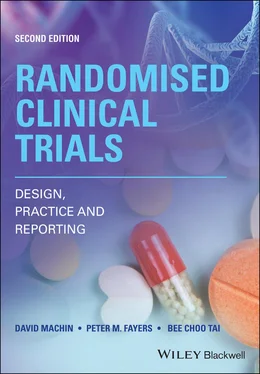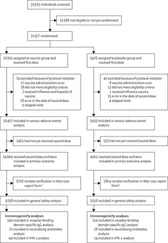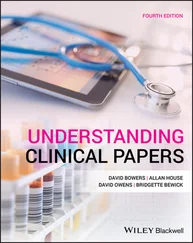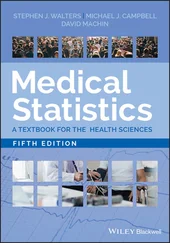1 Cover
2 Title Page Randomised Clinical Trials Design, Practice and Reporting Second Edition David Machin Leicester Cancer Research Centre University of Leicester, Leicester, UK Medical Statistics Group, School of Health and Related Research University of Sheffield, Sheffield, UK Peter M. Fayers Institute of Applied Health University of Aberdeen, Scotland, UK Bee Choo Tai Saw Swee Hock School of Public Health National University of Singapore and National University Health System Singapore Singapore, Singapore
3 Copyright Page
4 Dedication Page
5 Preface
6 PART I: Basic Considerations CHAPTER 1: Introduction 1.1 Introduction 1.2 Some completed trials 1.3 Choice of design 1.4 Practical constraints 1.5 Influencing clinical practice 1.6 History 1.7 How do trials arise? 1.8 Ethical considerations 1.9 Regulatory requirements 1.10 Focus 1.11 Further reading CHAPTER 2: Design Features 2.1 Introduction 2.2 The research question 2.3 Patient selection 2.4 The consent process 2.5 Choice of interventions 2.6 Choice of design 2.7 Assigning the interventions 2.8 Making the assessments 2.9 Analysis and reporting 2.10 Technical details 2.11 Guidelines 2.12 Further reading CHAPTER 3: The Trial Protocol 3.1 Introduction 3.2 Abstract 3.3 Background 3.4 Research objectives 3.5 Design 3.6 Intervention details 3.7 Eligibility 3.8 Randomisation 3.9 Assessment and data collection 3.10 Statistical considerations 3.11 Ethical issues 3.12 Organisational structure 3.13 Publication policy 3.14 Trial forms 3.15 Appendices 3.16 Regulatory requirements 3.17 Guidelines 3.18 Protocols CHAPTER 4: Measurement and Data Capture 4.1 Introduction 4.2 Types of measures 4.3 Measures and endpoints 4.4 Making the observations 4.5 Baseline measures 4.6 Data recording 4.7 Technical notes 4.8 Guidelines CHAPTER 5: Randomisation 5.1 Introduction 5.2 Rationale 5.3 Mechanics 5.4 Application 5.5 Carrying out randomisation 5.6 Documentation 5.7 Unacceptable methods 5.8 Guidelines CHAPTER 6: Trial Initiation 6.1 Introduction 6.2 Trial organisation 6.3 Data collection and processing 6.4 Internal data monitoring 6.5 Ethical and regulatory requirements 6.6 Launching the trial 6.7 Trial registries 6.8 Guidelines CHAPTER 7: Trial Conduct and Completion 7.1 Introduction 7.2 Regular feedback 7.3 Publicity 7.4 Protocol modifications 7.5 Preparing the publication(s) 7.6 The next trial? 7.7 Protocol CHAPTER 8: Basics for Analysis 8.1 Introduction 8.2 The standard Normal distribution 8.3 Confidence intervals 8.4 Statistical tests 8.5 Examples of analysis 8.6 Regression methods 8.7 Other issues 8.8 Practice 8.9 Technical details CHAPTER 9: Trial Size 9.1 Introduction 9.2 Significance level and power 9.3 The fundamental equation 9.4 Specific situations 9.5 Practical considerations 9.6 Further topics 9.7 Guideline 9.8 Software CHAPTER 10: Data and Safety Monitoring 10.1 Introduction 10.2 The DSMB 10.3 Early reviews 10.4 Interim reviews 10.5 Protocols CHAPTER 11: Reporting 11.1 Introduction 11.2 Publication 11.3 Responsibilities 11.4 Background 11.5 Methods 11.6 Findings 11.7 When things go wrong 11.8 Conclusions 11.9 Guidelines
7 PART II: Adaptions of the Basic Design CHAPTER 12: More Than Two Interventions 12.1 Introduction 12.2 Unstructured comparisons 12.3 Comparisons with placebo (or standard) 12.4 Dose–response designs 12.5 Factorial trials 12.6 Complex structure comparisons CHAPTER 13: Paired and Matched Designs 13.1 Matched‐pair trials 13.2 Cross‐over trials 13.3 Split‐mouth designs 13.4 Guidelines CHAPTER 14: Repeated Measures Design 14.1 Introduction 14.2 Simplified analysis 14.3 Regression models 14.4 Auto‐correlation 14.5 Accounting for auto‐correlation 14.6 The design effect (DE) 14.7 Trial size 14.8 Practicalities 14.9 Reporting 14.10 Matched organs receiving the same intervention CHAPTER 15: Non‐Inferiority and Equivalence Trials 15.1 Introduction 15.2 Non‐inferiority 15.3 Analysis 15.4 Trial size 15.5 Equivalence 15.6 Reporting 15.7 Practical Issues 15.8 Guidelines CHAPTER 16: Cluster Designs 16.1 Design features 16.2 Procedures 16.3 Regression models 16.4 Intra‐class correlation 16.5 Trial size 16.6 Analysis 16.7 Practicalities 16.8 Reporting 16.9 Further reading CHAPTER 17: Stepped Wedge Designs 17.1 Introduction 17.2 Notation 17.3 Basic structure 17.4 Randomisation 17.5 Cross‐sectional design 17.6 Closed cohort design 17.7 Practicalities
8 PART III: Further Topics CHAPTER 18: Genomic Targets 18.1 Introduction 18.2 Predictive markers 18.3 Enrichment design 18.4 Biomarker‐Stratified Designs 18.5 Adaptive threshold designs CHAPTER 19: Feasibility and Pilot Studies 19.1 Introduction 19.2 Feasibility studies 19.3 External‐pilot studies 19.4 Considerations across external‐pilot and main trial 19.5 Internal‐pilot studies 19.6 Other preliminary studies 19.7 Reporting CHAPTER 20: Further Topics 20.1 Introduction 20.2 Adaptive approaches 20.3 Large simple trials 20.4 Bayesian methods 20.5 Interim analyses 20.6 Zelen randomised consent designs 20.7 Systematic overviews
9 Statistical Tables
10 Glossary
11 References
12 Index
13 End User License Agreement
1 Chapter 3Table 2 Operational mattress definitions Table 4 Minimisation factors
2 Appendix Table T1 Random numbersTable T2 The Normal distribution function – Probability, γ , that a Normally ...Table T3 Percentage points of the standardised Normal distribution for given α ...Table T4 The value tabulated is t 1 − α/2, such that if X i...Table T5 Simon, Wittes and Ellenberg designTable T6 The multiplier κ of the estimated standard deviation, s Pilot, to ob...Table T7 Total sample size for a two equal group Main trial for standardised dif...Table T8 Optimal values of Pilot, Main and hence Overall two equal‐group compara...
1 Chapter 1 Figure 1.1 Individual patient reductions in disease activity (SASSAD) for th... Figure 1.2 The relative strength of evidence obtained from alternative desig... Figure 1.3 Special considerations for clinical trials in human subjects Figure 1.4 Avicenna’s rules for the experimental use and testing of drugs Figure 1.5 Sequential phases of developing randomised controlled trials of c...
2 Chapter 2 Figure 2.1 Individually randomised controlled trial of the effect of topical...
3 Chapter 3 Figure 3.1 Major components of a clinical trial protocol Figure 3.2 Part of the Information Sheet utilised in the multicentre COMPLIA... Figure 3.3 Consent form designed to obtain assent from a patient to be rando...
4 Chapter 4 Figure 4.1 Selected baseline, adverse event and endpoint results from a tria... Figure 4.2 Skin assessment scale used for the grading of pressure sores. Figure 4.3 Batch baseline mean and SD of estrone levels, and corresponding Z Figure 4.4 Registration form.Figure 4.5 Surgical complications form.Figure 4.6 Follow‐up form.Figure 4.7 Part of the Questionnaire (SVQ) for self‐assessment of sexual fun...Figure 4.8 General health question from SF‐36v2.
5 Chapter 5Figure 5.1 All possible permutations of block size 4 for two treatments A an...Figure 5.2 Randomised block design (RBD) for 24 units comprising two interve...Figure 5.3 Randomised block design (RBD) for 18 patients comprising three in...Figure 5.4 All possible permutations of block size 5 for two interventions S Figure 5.5 Stratification groups for a trial for alleviating urinary symptom...Figure 5.6 Distribution of patients with prostate cancer according to TURP a...Figure 5.7 Advantages and disadvantages of different types of randomisation...Figure 5.8 Key steps in preparing the randomisation list for a parallel grou...
6 Chapter 6Figure 6.1 Schematic representation of some stages involved when planning a ...Figure 6.2 Suggested details necessary for trial registration purposes.Figure 6.3 Aspects of the progress of a trial that require internal monitori...
Читать дальше












